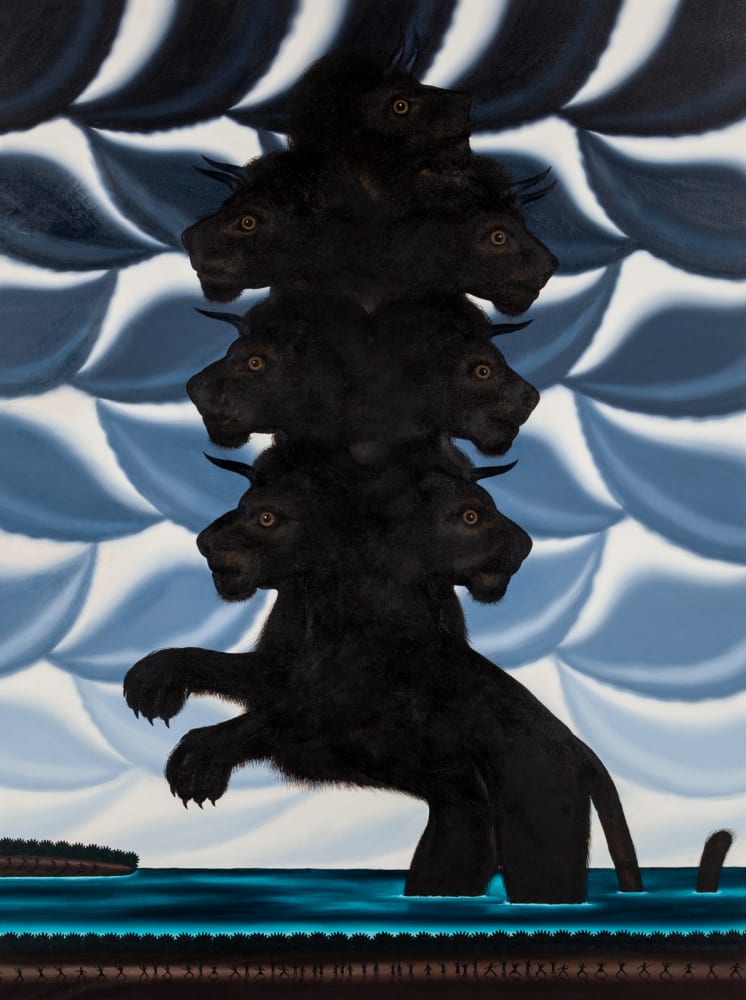Roger Brown American, Alabama, 1941-1997
Beast Rising from the Sea, 1983
Oil on canvas
72 x 54 in
182.9 x 137.2 cm
182.9 x 137.2 cm
4848
Roger Brown was raised in the Church of Christ, part of the evangelical restoration movement, widespread but unaligned through the American South. The intensely religious culture of the Deep South...
Roger Brown was raised in the Church of Christ, part of the evangelical restoration movement, widespread but unaligned through the American South. The intensely religious culture of the Deep South left a lasting impact on Brown’s character, inspiring him to initially pursue religious studies and even consider becoming a minister before leaving the South to attend art school at SAIC in Chicago.
Religious imagery remained pervasive throughout Brown’s entire career, perhaps most prominently images of Armageddon, the end of the world as described by the Biblical Book of Revelation. Hellfire and brimstone, boiling seas and bloody skies recurred throughout Brown’s career, along with tumbling towers and desiccated skeletons. Brown’s academic interest in Renaissance and pre-Renaissance European painting also naturally brought in religious reference, if only tangentially. In the 1980s, following the death of his partner George Veronda and the ravaging of the gay community by the HIV/AIDS crisis, Brown’s apocalyptic work became increasingly specific in illustrating exact single concepts, figures, and locations from Biblical storytelling, particularly from Revelations.
The Book of Revelation describes the coming of two “beasts” who are aligned against God in service of “the Dragon.” The first beast comes "out of the sea" and is given authority and power by the dragon. This first beast is initially mentioned in Revelation 11:7 as coming out of the abyss. His appearance is described in detail in Revelation 13:1-10, and some of the mystery behind his appearance is revealed in Revelation 17:7-18. The second beast comes "out of the earth" and directs all peoples of the earth to worship the first beast. The second beast is associated with Revelation 13:11-18 the false prophet.
So says Revelations, John saw it "rise up out of the sea, having seven heads and ten horns, and upon his horns ten crowns, and upon his heads the name of blasphemy." While crowns and blasphemy are perhaps left metaphorical, Brown structures the seven heads and ten hours in a surreal totemic arrangement, set against his iconic cloudy sky.
Religious imagery remained pervasive throughout Brown’s entire career, perhaps most prominently images of Armageddon, the end of the world as described by the Biblical Book of Revelation. Hellfire and brimstone, boiling seas and bloody skies recurred throughout Brown’s career, along with tumbling towers and desiccated skeletons. Brown’s academic interest in Renaissance and pre-Renaissance European painting also naturally brought in religious reference, if only tangentially. In the 1980s, following the death of his partner George Veronda and the ravaging of the gay community by the HIV/AIDS crisis, Brown’s apocalyptic work became increasingly specific in illustrating exact single concepts, figures, and locations from Biblical storytelling, particularly from Revelations.
The Book of Revelation describes the coming of two “beasts” who are aligned against God in service of “the Dragon.” The first beast comes "out of the sea" and is given authority and power by the dragon. This first beast is initially mentioned in Revelation 11:7 as coming out of the abyss. His appearance is described in detail in Revelation 13:1-10, and some of the mystery behind his appearance is revealed in Revelation 17:7-18. The second beast comes "out of the earth" and directs all peoples of the earth to worship the first beast. The second beast is associated with Revelation 13:11-18 the false prophet.
So says Revelations, John saw it "rise up out of the sea, having seven heads and ten horns, and upon his horns ten crowns, and upon his heads the name of blasphemy." While crowns and blasphemy are perhaps left metaphorical, Brown structures the seven heads and ten hours in a surreal totemic arrangement, set against his iconic cloudy sky.

